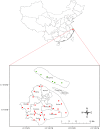Increasing plant diversity with border crops reduces insecticide use and increases crop yield in urban agriculture
- PMID: 29792597
- PMCID: PMC5967864
- DOI: 10.7554/eLife.35103
Increasing plant diversity with border crops reduces insecticide use and increases crop yield in urban agriculture
Abstract
Urban agriculture is making an increasing contribution to food security in large cities around the world. The potential contribution of biodiversity to ecological intensification in urban agricultural systems has not been investigated. We present monitoring data collected from rice fields in 34 community farms in mega-urban Shanghai, China, from 2001 to 2015, and show that the presence of a border crop of soybeans and neighboring crops (maize, eggplant and Chinese cabbage), both without weed control, increased invertebrate predator abundance, decreased the abundance of pests and dependence on insecticides, and increased grain yield and economic profits. Two 2 year randomized experiments with the low and high diversity practices in the same locations confirmed these results. Our study shows that diversifying farming practices can make an important contribution to ecological intensification and the sustainable use of associated ecosystem services in an urban ecosystem.
Keywords: Chinese cabbage; ecology; eggplant; maize; predator; rice; soybean.
© 2018, Wan et al.
Conflict of interest statement
NW, YC, YS, XJ, XW, XZ, WC, JL, YJ, XC, JW, JJ, MN, RJ, TY, JT, WT, HZ, BL No competing interests declared
Figures
















References
-
- Altieri MA, Companioni N, Cañizares K, Murphy C, Rosset P, Bourque M, Nicholls CI. The greening of the “barrios”: urban agriculture for food security in Cuba. Agriculture and Human Values. 1999;16:131–140. doi: 10.1023/A:1007545304561. - DOI
-
- Barlow J, Lennox GD, Ferreira J, Berenguer E, Lees AC, Mac Nally R, Thomson JR, Ferraz SF, Louzada J, Oliveira VH, Parry L, Solar RR, Vieira IC, Aragão LE, Begotti RA, Braga RF, Cardoso TM, de Oliveira RC, Souza CM, Moura NG, Nunes SS, Siqueira JV, Pardini R, Silveira JM, Vaz-de-Mello FZ, Veiga RC, Venturieri A, Gardner TA. Anthropogenic disturbance in tropical forests can double biodiversity loss from deforestation. Nature. 2016;535:144–147. doi: 10.1038/nature18326. - DOI - PubMed
-
- Barot S, Allard V, Cantarel A, Enjalbert J, Gauffreteau A, Goldringer I, Lata J-C, Le Roux X, Niboyet A, Porcher E. Designing mixtures of varieties for multifunctional agriculture with the help of ecology. A review. Agronomy for Sustainable Development. 2017;37:13. doi: 10.1007/s13593-017-0418-x. - DOI
Publication types
MeSH terms
Substances
LinkOut - more resources
Full Text Sources
Other Literature Sources

